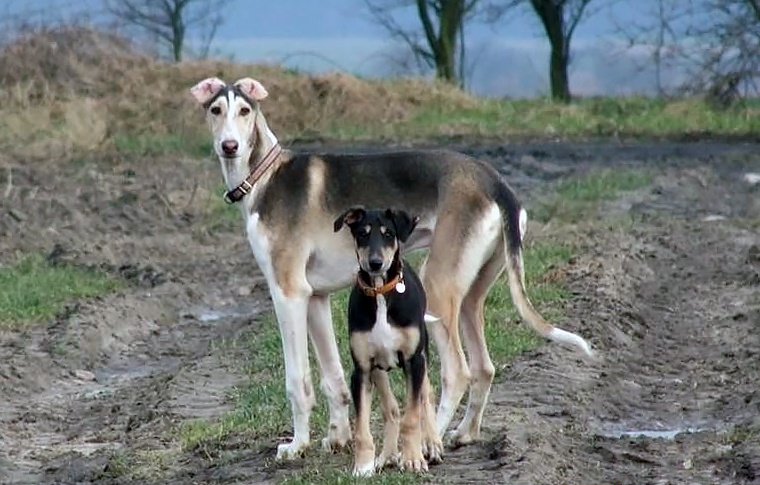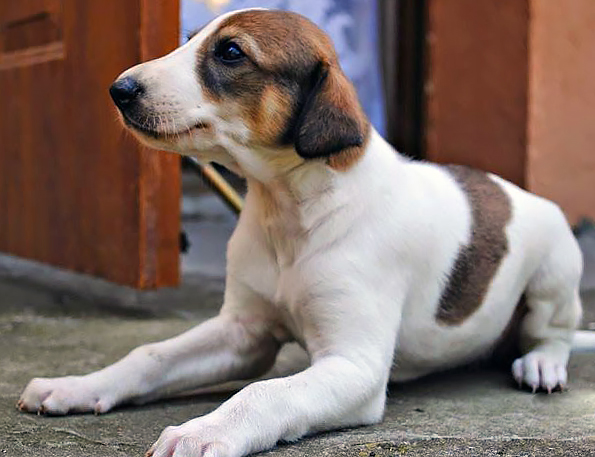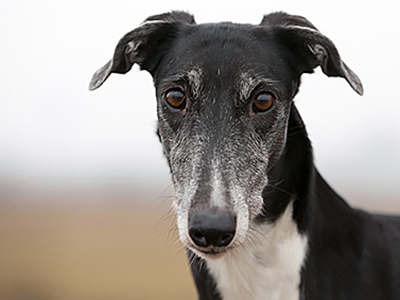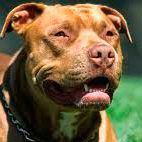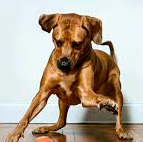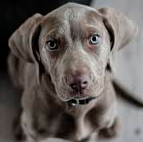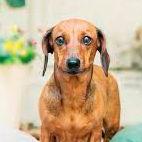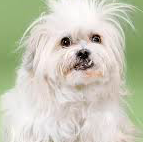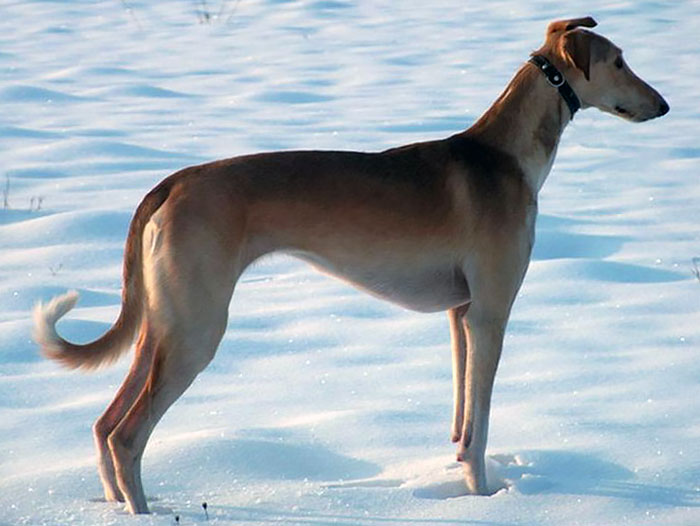
Chart Polski
Chart Polski pictures ➜
ORIGIN: Poland
GENERAL APPEARANCE AND BEHAVIOR CHARACTERISTICS
a) The Polish hound is a dog of great size, powerful, muscular, definitely stronger and less fine in shape than the other short-haired sighthounds (he must not however be heavy nor lethargic). In his appearance, he is close to the Asiatic greyhound, who is his ancestor. The strong frame, the concise structure of the body, the distinct musculature and the powerful jaws show that this dog has been used in the difficult conditions of the Polish climate for hunting not only the hare, fox, deer, and bustard, but also the wolf.
The expressive eyes, with a lively and penetrating look, play an important role in the general aspect of the Polish hound.
b) The gait (movement) must be flowing and energetic; the appropriate angulation of the fore and hindquarters allow an extension of the leg forward in a long and free stride at the walk as well as at the trot. The hounds led slowly may amble, but with acceleration of the speed of the gait, they should get back to the normal diagonal movement.
The action of the hindlegs is one of the characteristics; they can be placed in a convergent way, the hound “knits” (crossing legs) while on a restricted trot, which is not a fault.
c) The Polish hound is his own master, confident, reserved and brave. In the chase he is fast, very skilful and resistant. In action, he reacts quickly and brutally.
d) Size: the optimum size:
for the female is of 68-75 cm (27-30 inches) at the withers
for male is of 70-80 cm (28-32 inches) at the withers
Subjects bigger than the optimal size are permitted, with the condition that the typical morphology is safeguarded. A slightly smaller size than that of the model is however not an eliminating fault if, apart from that, the hound does not raise any reservation.
The proportion of the length of the body in relation to the height at the withers should be 102-103%. All important deviation from these proportions is a fault.
In the free-standing hound, the height at the withers should be equal to the height at the level of the sacral vertebraes.
HEAD
a) Strong, lean and long.
b) Proportions: length of head in relation to the height at the withers:
In the males 37-39%
In the females 36-38%
- Length of muzzle in relation to the skull:
- 1:1 but the muzzle may be slightly longer,
- the proportion of the width of the head at the zygomatic arches’ level in relation to the length of the head: about 38%
- the desirable proportion of the perimeter of the muzzle in front of the eye sockets in relation to the length of the head: about 80%.
c) The upper part of the skull should be flat; frontal furrow lightly pronounced, of a desirable depth of 0,51 cm.
d) Frontal protrusion, upper orbital arches, nasal-frontal depression lightly marked.
e) The lateral line of the skull should blend in perfectly with the lateral line of the muzzle.
f) The upper lines of the muzzle and the skull should be slightly divergent. A slight bump which often appears on the upper line of the foreface is non-eliminating.
g) Strong muzzle tapering towards the nose so gently that it does not give the impression of being pointed, but of rather being blunt for a greyhound.
h) Nose black or dark, large, rising above the lips.
i) Jaws and teeth strong. Scissor bite, pincer bite acceptable.
j) Lips fully defined, lean without excess; in the first part of the muzzle, they may form a minor fold covering the pigmented borders of the bottom lip, but are never pendulous and do not hide the bottom jaw.
k) Eyes: desirable dark eyes according to the dog’s coat. The iris is of a shade going from dark brown to amber color, expressive, rather large, slightly set on the slant (eye almond shaped). Small triangular eyes are eliminatory. The protruding eyes are a severe fault. The expression of the eyes must be characteristic: lively and penetrating.
l) Ears: of average size, quite narrow; when straightened out their extremities easily touch the inner angles of the eyes. Set at eye level. The pavilion of the ear has a relatively soft cartilage, the ears give the impression of being quite fleshy. Admitted ear carriage:
– bent (folded) backwards, touching the neck.
– roof shape position,
– In a state of excitement, ears fully erect, or with the extremities slightly bent forward.
NECK
Long, muscular, powerful, oval in profile, rising slightly from the line of the withers. Head carried rather high (the Polish hound at rest carries the head slightly lower then the greyhound).
BODY
a) Withers small, but marked, top line straight in the thoracic part, slightly arched in the lumbar region. In the females the almost straight top line in the lumbar region is not a fault.
b) Thoracic cage (ribcage) very spacious and well let down (the ideal is a ribcage reaching the point of the elbow in the sternal region), moderately wide seen from the front; the ribs behind the vertical line passing by the extremity of the manubrium of the sternum, should be clearly arched but not barrel shaped. Long ribs, placed on a slant in relation to the spinal column. Sternum long.
c) Abdomen tucked up.
d) Loin wide and muscular.
e) Rump oblique, slightly slanting, long, muscular and wide; points of the hip bones wide apart, (the width between the hip bones represents 12-14% of the height at the withers.)
TAIL
Long, thick at the base, at rest carried low, the extremity of the tail should be in the shape of a hook curved upwards or forming a complete ring. While at rest, dog may lift the tail completely. On the move, the tail may be carried higher, although the base of the tail should not be carried higher than the level of the loin.
FOREQUARTERS
a) Long, lean, muscular, not too wide apart. Seen from the front the legs should be parallel.
b) Forearm long; the proportion of the distance from the point of the elbow to the ground (from the height at elbow level) in relation to the height at the withers should be of about 54% and be balanced so that the hound does not give the impression of being excessively high on the leg.
c) Pasterns slightly oblique in relation to the ground.
d) Feet oval, toes tightly closed, well curved.
HINDQUARTERS
a) Long, muscular, quite well angulated, slightly stretched towards the back and slightly apart on the sides, but definitely less than in the greyhound. Seen from behind the legs should be parallel.
b) Long leg.
c) Strong hock.
d) Oval feet, but much longer than the front feet; toes well arched, compact.
SKIN – COAT
a) Tight fitting skin, elastic.
b) Coat springy to the touch, rather harsh, not “wire-haired” but not silky either. Of variable lengths over all the body. On the withers the coat is on the whole longer, shorter on the sides; it is on the sternum and the legs where it is the shortest. The hair on the abdomen is more delicate, more sparse. It is at the back of the tail and underneath the tail that the hair is longer, but also harsh, forming culottes and a brush.
c) Color of coat: all colors are permitted. Border of the eyelids and nose black or dark, when the color of the coat is lighter, i.e., blue or beige; the nose is in relation, blue or beige.
FAULTS
a) General aspects:
– Fragile bone structure, weak, musculature weak or lethargic constitution, drowsiness, exaggerated timidity, unfounded aggressiveness.
b) Head:
– Frontal part too convex.
– Muzzle too convex.
– Frontal furrow too defined, stop too pronounced.
– Flews excessively developed, weak jaws.
– Nose fine, pointed.
– Lower prognathism, upper prognathism; important teeth missing (with the exception of P1); protruding eyes; ears flat against sides of head.
c) Neck:
– Neck short, fine, exaggerated high head carriage (as in the Italian greyhound) or exaggerated low head carriage (as in the Borzoi).
d) Body:
– Arched back from the thoracic vertebrae on, or lumbar region too convex.
– Sternum short, ribcage flat, not enough let down; manubrium of the sternum receding, so that, when looking in profile, it is not seen behind the edge of the shoulder.
e) Tail:
– Completely curved over the back or carried sideways.
f) Forequarters:
– Straight in shoulder, feet turning out, deformed pads, out or in at the elbows.
g) Hindquarters:
– Angulation too weak, cow-hocked, barrel shaped, splayed feet.
h) Skin and Coat:
– Skin thick, loose and not much elastic; nose and border of eyelids of a pinky color or speckled, as well as lightening of the color of the nose and border of eyelids in the colors other than blue or beige coats.
Note
Males should have two apparently normal testicles fully descended into the scrotum.


